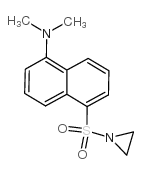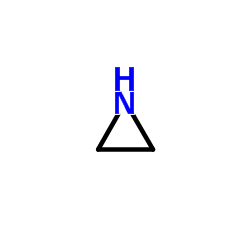5-DIMETHYLAMINONAPHTHALENE-1-SULFONYL AZIRIDINE
Modify Date: 2025-08-25 10:09:01

5-DIMETHYLAMINONAPHTHALENE-1-SULFONYL AZIRIDINE structure
|
Common Name | 5-DIMETHYLAMINONAPHTHALENE-1-SULFONYL AZIRIDINE | ||
|---|---|---|---|---|
| CAS Number | 51908-46-4 | Molecular Weight | 276.35400 | |
| Density | 1.356g/cm3 | Boiling Point | 436ºC at 760mmHg | |
| Molecular Formula | C14H16N2O2S | Melting Point | N/A | |
| MSDS | N/A | Flash Point | 217.5ºC | |
| Name | 5-(aziridin-1-ylsulfonyl)-N,N-dimethylnaphthalen-1-amine |
|---|---|
| Synonym | More Synonyms |
| Density | 1.356g/cm3 |
|---|---|
| Boiling Point | 436ºC at 760mmHg |
| Molecular Formula | C14H16N2O2S |
| Molecular Weight | 276.35400 |
| Flash Point | 217.5ºC |
| Exact Mass | 276.09300 |
| PSA | 48.77000 |
| LogP | 2.92880 |
| Index of Refraction | 1.684 |
| InChIKey | LSKWDEYBJACPBB-UHFFFAOYSA-N |
| SMILES | CN(C)c1cccc2c(S(=O)(=O)N3CC3)cccc12 |
Synonym:None Section 2 - COMPOSITION, INFORMATION ON INGREDIENTS
Risk Phrases: 20/21/22 Section 3 - HAZARDS IDENTIFICATION EMERGENCY OVERVIEW
Harmful by inhalation, in contact with skin and if swallowed.Cancer suspect agent.The toxicological properties of this material have not been fully investigated. Potential Health Effects Eye: May cause eye irritation. Skin: May cause skin irritation. Ingestion: May cause gastrointestinal irritation with nausea, vomiting and diarrhea. The toxicological properties of this substance have not been fully investigated. Inhalation: May cause respiratory tract irritation. The toxicological properties of this substance have not been fully investigated. Chronic: May cause cancer according to animal studies. Section 4 - FIRST AID MEASURES Eyes: Immediately flush eyes with plenty of water for at least 15 minutes, occasionally lifting the upper and lower eyelids. Get medical aid immediately. Skin: Immediately flush skin with plenty of water for at least 15 minutes while removing contaminated clothing and shoes. Get medical aid if irritation develops or persists. Ingestion: If victim is conscious and alert, give 2-4 cupfuls of milk or water. Never give anything by mouth to an unconscious person. Get medical aid. Inhalation: Remove from exposure and move to fresh air immediately. If not breathing, give artificial respiration. If breathing is difficult, give oxygen. Get medical aid. Notes to Physician: Section 5 - FIRE FIGHTING MEASURES General Information: As in any fire, wear a self-contained breathing apparatus in pressure-demand, MSHA/NIOSH (approved or equivalent), and full protective gear. During a fire, irritating and highly toxic gases may be generated by thermal decomposition or combustion. Extinguishing Media: Substance is nonflammable; use agent most appropriate to extinguish surrounding fire. Section 6 - ACCIDENTAL RELEASE MEASURES General Information: Use proper personal protective equipment as indicated in Section 8. Spills/Leaks: Vacuum or sweep up material and place into a suitable disposal container. Reduce airborne dust and prevent scattering by moistening with water. Clean up spills immediately, observing precautions in the Protective Equipment section. Section 7 - HANDLING and STORAGE Handling: Wash thoroughly after handling. Wash hands before eating. Remove contaminated clothing and wash before reuse. Use with adequate ventilation. Avoid contact with skin and eyes. Avoid ingestion and inhalation. Storage: Store in a cool, dry place. Keep container closed when not in use. Section 8 - EXPOSURE CONTROLS, PERSONAL PROTECTION Engineering Controls: Use adequate ventilation to keep airborne concentrations low. Exposure Limits CAS# 51908-46-4: Personal Protective Equipment Eyes: Wear appropriate protective eyeglasses or chemical safety goggles as described by OSHA's eye and face protection regulations in 29 CFR 1910.133 or European Standard EN166. Skin: Wear appropriate protective gloves to prevent skin exposure. Clothing: Wear appropriate protective clothing to prevent skin exposure. Respirators: Follow the OSHA respirator regulations found in 29 CFR 1910.134 or European Standard EN 149. Use a NIOSH/MSHA or European Standard EN 149 approved respirator if exposure limits are exceeded or if irritation or other symptoms are experienced. Section 9 - PHYSICAL AND CHEMICAL PROPERTIES Physical State: Solid Color: pale yellow Odor: None reported. pH: Not available. Vapor Pressure: Not available. Viscosity: Not available. Boiling Point: Not available. Freezing/Melting Point: 90 deg C Autoignition Temperature: Not applicable. Flash Point: Not applicable. Explosion Limits, lower: Not available. Explosion Limits, upper: Not available. Decomposition Temperature: Not available. Solubility in water: Insoluble in water. Specific Gravity/Density: Not available. Molecular Formula: C14H16N2O2S Molecular Weight: 276.1842 Section 10 - STABILITY AND REACTIVITY Chemical Stability: Stable under normal temperatures and pressures. Conditions to Avoid: Incompatible materials. Incompatibilities with Other Materials: Strong oxidizers. Hazardous Decomposition Products: Carbon monoxide, oxides of nitrogen, oxides of sulfur, irritating and toxic fumes and gases, carbon dioxide. Hazardous Polymerization: Will not occur. Section 11 - TOXICOLOGICAL INFORMATION RTECS#: CAS# 51908-46-4 unlisted. LD50/LC50: Not available. Carcinogenicity: Dansyl Aziridine - Not listed by ACGIH, IARC, or NTP. Section 12 - ECOLOGICAL INFORMATION Section 13 - DISPOSAL CONSIDERATIONS Products which are considered hazardous for supply are classified as Special Waste and the disposal of such chemicals is covered by regulations which may vary according to location. Contact a specialist disposal company or the local waste regulator for advice. Empty containers must be decontaminated before returning for recycling. Section 14 - TRANSPORT INFORMATION IATA No information available. IMO No information available. RID/ADR No information available. Section 15 - REGULATORY INFORMATION European/International Regulations European Labeling in Accordance with EC Directives Hazard Symbols: XN Risk Phrases: R 20/21/22 Harmful by inhalation, in contact with skin and if swallowed. Safety Phrases: S 25 Avoid contact with eyes. WGK (Water Danger/Protection) CAS# 51908-46-4: No information available. Canada None of the chemicals in this product are listed on the DSL/NDSL list. CAS# 51908-46-4 is not listed on Canada's Ingredient Disclosure List. US FEDERAL TSCA CAS# 51908-46-4 is not listed on the TSCA inventory. It is for research and development use only. SECTION 16 - ADDITIONAL INFORMATION N/A |
|
~84% 
5-DIMETHYLAMINO... CAS#:51908-46-4 |
| Literature: Xue; Bradshaw; Chiara; Savage; Krakowiak; Izatt; Prodi; Montalti; Zaccheroni Synlett, 2000 , # 8 p. 1181 - 1183 |
| Precursor 2 | |
|---|---|
| DownStream 0 | |
| HS Code | 2933990090 |
|---|---|
| Summary | 2933990090. heterocyclic compounds with nitrogen hetero-atom(s) only. VAT:17.0%. Tax rebate rate:13.0%. . MFN tariff:6.5%. General tariff:20.0% |
| EINECS 257-508-2 |
| Dansylaziridine |
| 5-DIMETHYLAMINONAPHTHALENE-1-SULFONYL AZIRIDINE |
| Aziridine,N-dansyl |
| N-DANSYLAZIRIDINE |

